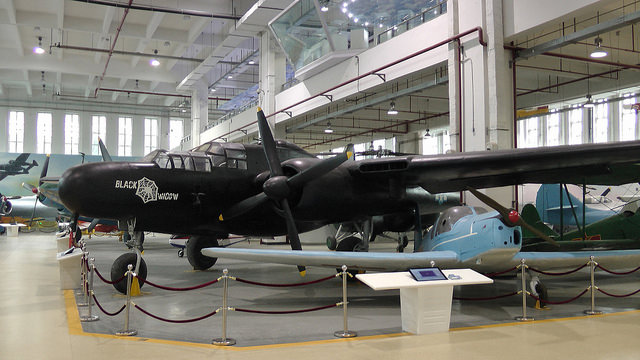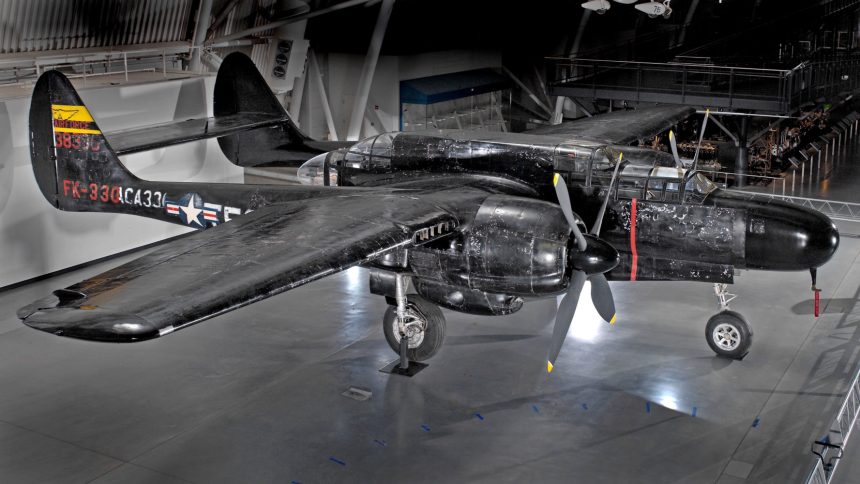Northrop’s night fighter was large, heavily armed, and fast for its size; the United States first night fighter designed from the ground up could find enemy aircraft in the dark thanks to advancements in radar technology.
A Shot in the Dark
Northrop’s night fighter was the result of American observations of the Battle of Britain and the night fighting capabilities of both the British and the Germans. Realizing the United States was lagging behind in this arena of aerial combat; specifications were established in October of 1940 for a designated night fighter aircraft capable of carrying the British Airborne Intercept (AI) radar.
The British had developed the AI radar in mid-1940, but the RAF (Royal Air Force) lacked an aircraft suited to carry the equipment and a radar operator that could also remain aloft for eight hours or more. The British Purchasing Commission was shopping aircraft in America’s inventory to meet these needs, but finding none. This situation, coupled with America’s lack of an extensively designed night fighter, prompted meetings with Jack Northrop and his Chief of Research, Vladimir Pavlecka, and led to Northrop presenting a proposal to the Air Material Command on Nov. 5, 1940.
Northrop’s accepted and then refined proposal included a large twin engine, twin-boom, heavily armed aircraft, with a crew of three. The crew consisted of a pilot, gunner, and radar operator. Armament would include four Browning M2 .50 caliber machine guns in a top turret, and four 20mm Hispano cannon, which were eventually moved from the wings to the lower fuselage. Two R-2800 Pratt & Whitney Double Wasp engines provided the needed power, and the nose housed the Western Electric SCR-720A radar, developed from the original British designs. The result was a heavy aircraft for a fighter, weighting in at up to over 32,000 pounds fully loaded. The aircraft was also large, with wingspan of 66 ft. and a length of over 48 ft., and standing over 14 ft. high.
Two XP-61 prototypes were ordered on Jan. 11, 1941, with thirteen more aircraft designated YP-61’s ordered the following March. September saw the first production order of 150 aircraft. The first XP-61 prototype flew on May 21, 1942.
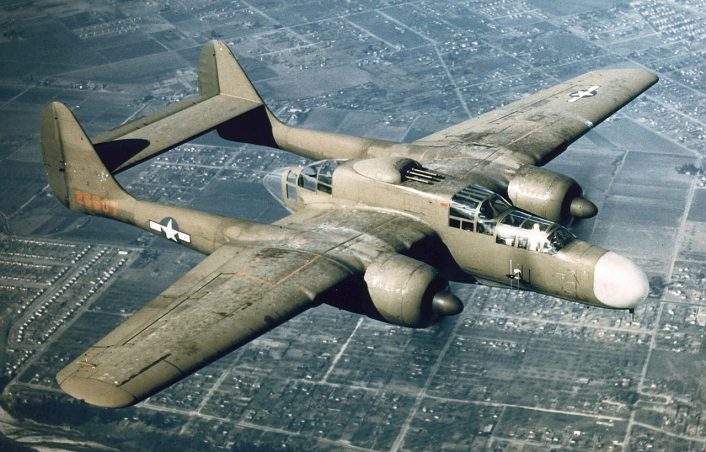
Into Production – The P-61A
Production P-61As began to arrive in service at the end of 1943, with the first of 200 of the model being accepted in October. The P-61A had an improved and strengthened canopy over the prototypes, with the first 45 aircraft produced being powered by the R-2800-10 engines producing 2,000 horsepower each, the later A models received the R-2800-65 engines capable of 2,250 horsepower. Maximum speed was over 360 mph, and range was around 1,200 miles, but could be increased with external tanks to 1,900 miles. Service ceiling was between 33,000 and 34,000 feet.
Many of the P-61As had the dorsal gun barbette eliminated due to buffeting issues. The dorsal gun turret housing the four .50 caliber machine guns was capable of 360 degree rotation and could be elevated 90 degrees. It could be operated to engage targets by the pilot or crewmen using two sighting stations, one in the cockpit and one in the radar operator’s compartment. The electrically powered turret could also be locked in the forward firing position by the pilot and used in conjunction with the 20 mm cannons. Four magazines mounted below the guns held 560 rounds for each gun. It was soon discovered flash suppressors were needed on the guns to prevent temporary night blindness of the crew while firing them.
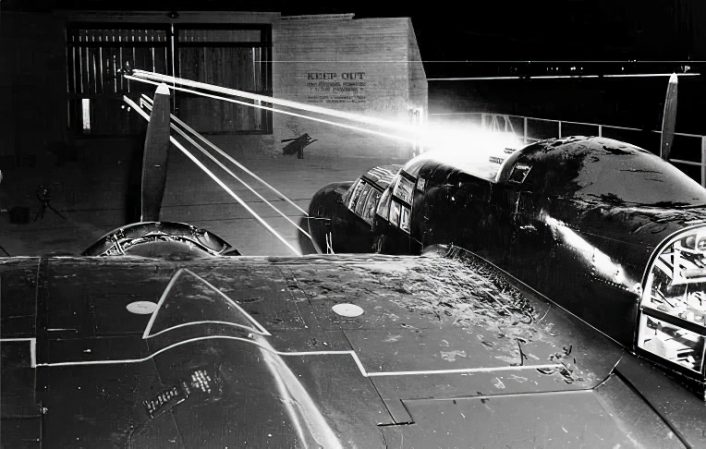
In 1944 the P-61A achieved its first “kills” in the South Pacific, replacing and sometimes augmenting the struggling and makeshift Douglas P-70 aircraft, which were A-20 “Havoc” bombers converted to night fighters. The P-70 had difficulty reaching the altitudes of some of the harassing Japanese bombers flying against U.S. troops at night. A Mitsubishi B4N “Betty” bomber was shot down in June 1944 by a Black Widow. Soon the P-61 owned the night skies.
The P-61B
The P-61B differed from the previous A model by an extended nose section to accommodate the improved SCR-72C radar. The landing gear doors on the main gear were also redesigned, allowing the lower portion to be closed after on the ground with the gear extended in order to prevent the debris associated with operating from forward unimproved airfields, such as rocks, dirt, and mud. Night vision binoculars and a taxi light added to the front landing gear were also new with the B model. Many of the P-61B models carried the upper gun turret and also could carry four external drop tanks. Four bombs of up to 1,600 lbs. could be carried in place of the fuel tanks as well. A total of 450 P-61B models were produced.
The P-61C
Over 500 of the P-61C models powered by the turbo-supercharged R-2800-73 engines producing 2,800 horsepower were ordered, but only 41 produced before the war ended in August 1945. The new engines made this a much more formidable aircraft; increasing speed to 430 mph and adding a higher maximum take-off weight, as well as better high altitude performance.
The Widow’s Victims
The P-61 was credited with 53 manned aircraft kills and downing 9 German V-1 Buzz Bombs in the European Theater, 5 manned aircraft in the Mediterranean Theater, 64 manned aircraft in the Pacific Theater, and 5 more aircraft in the China Burma India Theater. The Black Widow proved to be versatile and deadly, and could be flown only by the pilot without the radar operator or gunner. Although the planes never made it as originally intended to serve with the British as night fighters, they did take the fight to the enemies of America and helped end the Axis domination of the night skies.
A single P-61B Black Widow is credited with the last two “kills” of the war. Sporting elaborate nose art, Lady in the Dark of the 548th Squadron based at Le Shima, forced down a Japanese Nakajima Ki-43 “Oscar” on the last night of hostilities, Aug. 14, 1945. Lady in the Dark didn’t fire a single shot, forcing the Japanese aircraft down into the sea while giving chase. Incredibly, the following night, almost 24 hours after hostilities had officially ended; Lady in the Dark forced down yet another Japanese aircraft without firing a single shot, a belligerent Nakajima Ki-44 “Tojo”.
Twelve United States Army Air Force (USAAF) P-61B aircraft were transferred to the United States Navy/Marine Corps in late 1945 and used as unarmed radar-equipped night fighter trainers for the new Douglas F3D Skynight. The Navy/Marine Corps designation for the aircraft was the F2T-1N.
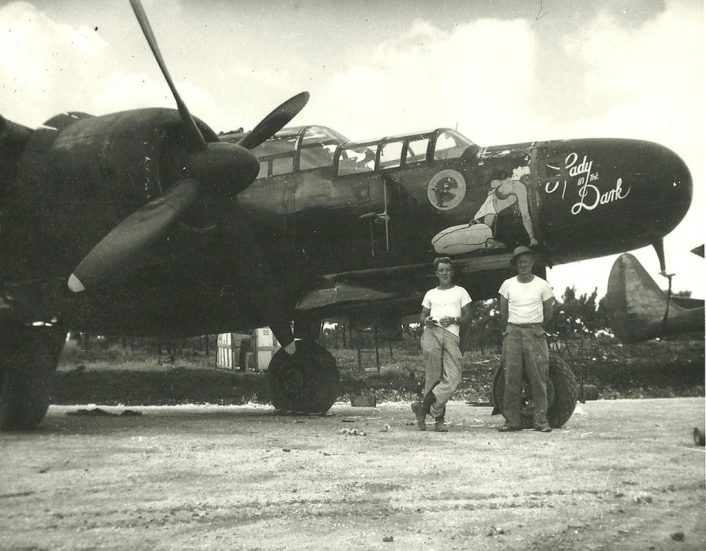
The X-Models
Refinements to the original airframe continued late into and after the war. One result was the XP-61C/D, with two prototypes built from P-61As. Improved R-2800-14 turbo-supercharged engines and eventually large paddle-bladed propellers were installed. Performance was enhanced, however constant maintenance and engine issues, coupled with the production of the P-61C led to the project being abandoned.
The XP-61E models (2 built) were produced from converted P-61B’s and intended to be long-range daytime escort fighters. A larger bubble type canopy replaced the turret and the crew nacelle was completely redesigned. The aircraft had a crew of two in tandem, a pilot and co-pilot/navigator. With four 310 gallon auxiliary fuel tanks, the 22,000 lb. aircraft could achieve a range of over 4,000 miles. It carried four .50 caliber machine guns in the nose in place of the radar and retained the four 20 mm cannon as well. The XP-61E could reach the speed of 376 mph. One prototype was damaged during an accident on Apr. 11, 1945 and written off, the surviving XP-61E went on to become the XF-15 photo reconnaissance prototype.
The XF-15 retained most of the design of the XP-61E, but the armament was removed from the nose section and replaced with camera gear. The 20 mm cannon were also removed and the area used for fuel tanks. Six windows in the nose had cameras behind them, with the controls for the cameras located in the aft cockpit and controlled by the copilot. An XF-15A was also built from a P-61C to further prove the concept.
Not the F-15A Eagle
The photo reconnaissance version was put into production as the F-15A “Reporter”, later re-designated the RF-61. The first F-15A arriving in Sept. 1946 were built as new aircraft using the wings, booms, engines, and tails from the P-61C and not converted from existing P-61s. A large roll-back canopy provided excellent visibility. A total of 36 were built, some went on to participate in Project Thunderstorm, a joint services and U.S. Weather Bureau endeavor in 1946 to explore methods of flying through violent storms. The first production F-15A, serial number N45-59300, served with NACA (National Advisory Committee for Aeronautics), the predecessor to NASA (National Aeronautics and Space Administration); as a mothership for dropping experimental transonic designs of the Ames Aeronautical Laboratory. It went on to become a fire fighter aircraft in California in the 1960’s, being lost in a crash in 1968. F-15As were also used to map North Korea from bases in Japan at the start of the Korean War.
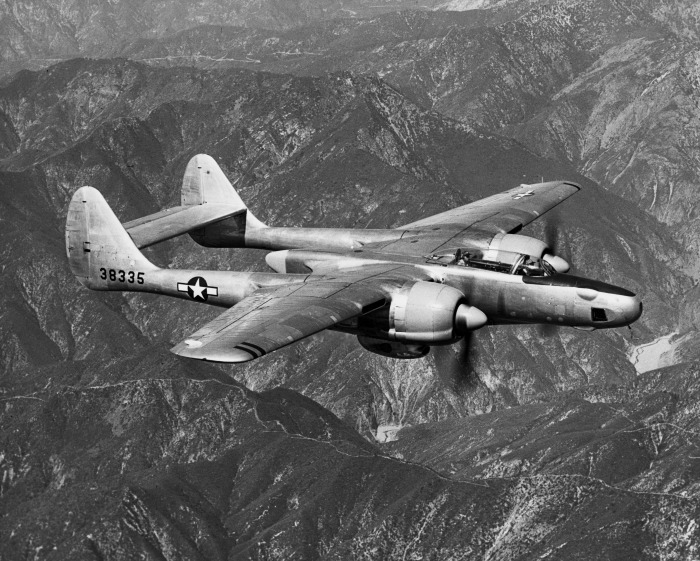
Re-designated and Replaced
In June of 1948 the P-61 (P for pursuit) was re-designated the F-61 (fighter) by the now United States Air Force. Flying for the Air Defense Command, the aircraft was soon being replaced in the late 1940’s by the F-82 Twin Mustangs that had been adapted for the all-weather/night fighter role.
There are currently only four known P-61 Black Widows still in existence, all in museums. One of particular note is in the Beijing Air and Space Museum in Beijing, China. The aircraft had served in the China Burma India Theater. The story goes that at the end of the war Communist Chinese came to a U.S. forward airfield ordering the Americans to leave but to leave their aircraft. Three P-61s were taken by the Chinese, two being wrecked later. The surviving example was moved about as a display aircraft, finally being repainted and moved inside to its current location. The other three surviving Black Widows are located at the Mid-Atlantic Air Museum in Reading Pennsylvania, the Steven F. Udvar-Hazy Center of the Smithsonian National Air and Space Museum in Chantilly, Virginia, and one resides in the National Museum of the United States Air Force in Dayton Ohio.
